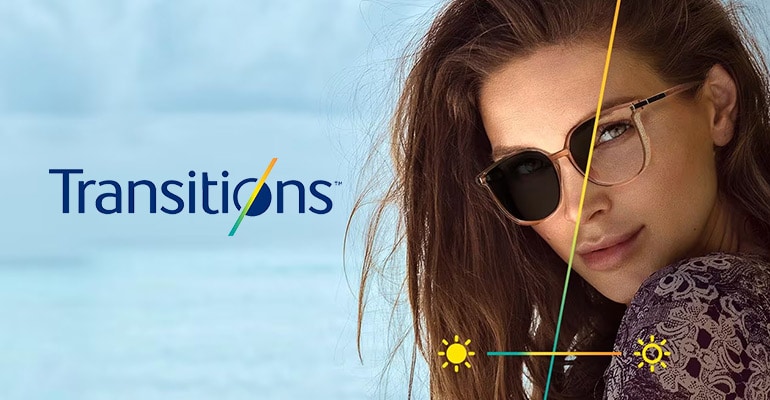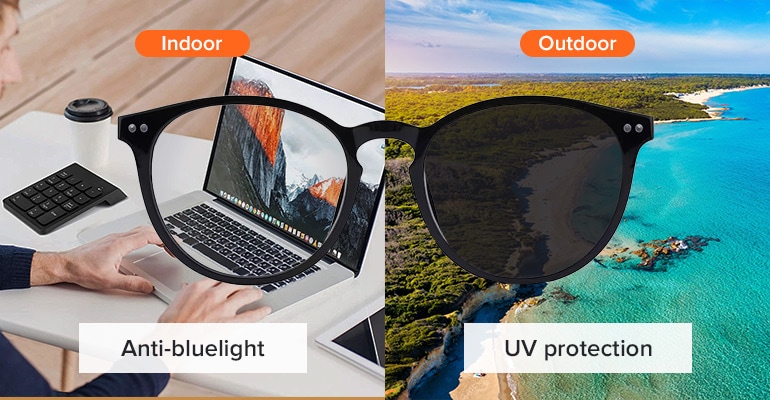Photochromic vs Transition Lenses: Which Adaptive Eyewear is Right for You
Jul 29, 2024

Always squinted for your sunglasses only to discover they were on your head? Alternatively, stumbled in your luggage, briefly dazzled by the sun, hoping your regular glasses could do more. Many people who use eyeglasses are conflicted between clear vision indoors and sun protection outdoors.
But if a solution fits your surroundings perfectly, it removes the need for a separate pair of prescription sunglasses. Now, enter the realm of light-adaptive eyewear, where photochromic frames and transition lenses take the front stage. This guide will help you navigate these innovative options and find the perfect fit for your ever-changing visual needs.
What are photochromic lenses?
A ground-breaking eyewear technology, photochromic lenses—known as light-adaptive lenses—darken in the sun and in reaction to ultraviolet (UV) rays. Often called Transition lenses, these glasses let you enjoy outdoor activities comfortably, free from the bother of glare.
How do light-responsive lenses work? Trillions of photochromic molecules found in transition lenses react under UV light. Simultaneous structural modification of these molecules causes darkening throughout the lens surface. As you thus enter the sunlight, the lenses quickly adjust to provide better visual comfort and protect your eyes from damaging UV radiation. On the other hand, the molecule structure reverses and progressively fades the lens back to its clear condition as you distance from UV radiation.
Photochromic lenses, also named tint changing glasses-including Transition lenses-offer a practical answer for people looking for eyewear that effortlessly adjusts to changing light situations. They provide constant UV ray protection while preserving the best visual clarity, removing the need to alternate between ordinary glasses and sunglasses. Thus, consider the fantastic advantages of photochromic lenses or transition lenses if you want eyewear that perfectly adapts to your surroundings.
What are transition lenses, and how do they work?
Transition lenses, sometimes referred to as photochromic lenses, are a kind of eyewear that changes with light conditions. The Transitions® company, which makes the most often used brand of photochromic glasses in the United States, derives the word “transition”. Additional names for these lenses are photochromatic, variable tint, or light-responsive lenses.
How Does Transition® Lenses Perform? They use a technique known as imbibing to pull a photochromic dye below the lens's surface using heat. When the lens material does not readily imbibe, another method called Trans-Bonding™ is used.
Transition lenses provide a practical answer for people looking for eyewear that fits changing lighting circumstances. These lenses preserve the best visual clarity while offering continuous protection against damaging UV rays by removing the need to change between ordinary glasses and sunglasses. Whether your preferred brand is Transition or photochromic lenses, they have excellent performance technology that improves your eyewear experience.

Photochromic vs. Transitions, which is better?
Though all Transitions® lenses are photochromic, not all are photochromic lenses when compared to each other. Several essential distinctions set the Transitions® brand apart from generic variations.
Transitions® lenses primarily benefit from speed. Their relatively fast activation and fade-back times—which depend on the amount of sunlight striking the lenses—are well-known. Conversely, typical photochromic lenses could have different activation and fade-back times depending on the brand and kind of lens.
One also has to consider the darkness levels provided by the lenses. Depending on the particular product line, Transitions® lenses range in darkness from somewhat light to quite dark. This adaptability lets you decide on the degree of tint that best fits your needs and tastes. By contrast, regular photochromic lenses could have a smaller range of darkness.
Regarding variance, Transitions® lenses present more choices than conventional photochromic spectacles. Each of the several product lines offered by the Transitions® brand has advantages and characteristics. Transitions® Signature® GEN S lenses, for instance, block 100% of UVA/UVB rays and filter damaging blue light from screens and the sun while also providing stylish styles and a range of color choices. For people sensitive to light or regularly exposed to intense light, Transitions™ XTRActive® lenses are clear indoors with a trace of protective tint and darken outdoors and even in the car. However, regular photochromic lenses do not polarize in the vehicle since the windshield filters UV light. Thus, Transitions® XTRActive® Polarized™ lenses also darken in the car and outdoors to reach a dynamic polarization efficiency of up to 90%. Regular photochromic lenses might not have these specific choices available.
In terms of durability and cost, Transitions® lenses typically last around two years and often come with quality assurance and a guarantee, given the brand's reputation. GlassesShop, founded in Michigan in 2004, is one of the largest online eyewear stores worldwide and offers a 365-day guarantee for customer satisfaction. While Transitions® lenses may be more expensive than ordinary photochromic lenses due to their brand name and technological advancements, GlassesShop provides competitive pricing options. Transition lenses at GlassesShop range from Transitions® Signature® GEN S (Refractive index selection: 1.50, 1.59, 1.61, 1.67; starting at $65-$94), Transitions™ XTRActive® (Refractive index selection: 1.50, 1.61, 1.67; starting at $75-$120), to Transitions® XTRActive® Polarized™ (Refractive index selection: 1.50, 1.61, 1.67; starting at $90-$140). In contrast, ordinary photochromic lenses at GlassesShop range from (Refractive index selection: 1.57, 1.59, 1.61; starting at $32-$71). Additionally, GlassesShop offers a BOGO (buy one get one free) offer, providing further affordability and convenience.
What are the pros and cons of photochromic lenses?
Transitions® lenses and other photochromic lenses offer numerous benefits. Here come!
Convenient: No Need to Change
Convenience is one significant advantage. Because photochromic lenses automatically adapt to changing light situations, there is no need to continually alternate between ordinary glasses and sunglasses. This saves the trouble of lugging and adjusting several pieces of eyewear.
Cost-Effective: Continuous Protection
Furthermore, cost-effective photochromic lenses reduce the need for separate sunglasses by offering continuous protection from damaging UV radiation.
Easy Care and Maintenance
Additionally, photochromic lenses are easy to care for, requiring the same maintenance as regular eyeglasses. They seamlessly fit into your daily routine.
Several Options Available
Furthermore, photochromic glasses provide several options regarding darkness levels and brands, thus letting users select the degree of tint best for their needs and taste.
Although Transitions® lenses and other photochromic lenses have many benefits, one should also consider their limitations. Because the windshield of a car filters UV rays needed for some photochromic lenses to darken, some of them may be less effective behind the windshield. The brand and lens type will also affect the degree of darkening, so selecting a reliable brand for constant performance is advisable. Furthermore, lacking glare shielding, unpolarized versions of photochromic lenses could be disadvantageous for those often in solid sunlight or glare.
For their eyewear needs, many consumers find photochromic frames to be a sensible and flexible option despite these restrictions.

Shop the high-quality light responsive eyewear from GlassesShop
Photochromic lenses, among other premium light-responsive eyeglasses, are available from GlassesShop. We offer choices for prescription eyewear, bifocals, blue block glasses, reading glasses, and sunglasses with several lens qualities, including Basic Tint, Gradient Tint, Mirrored Lens, and Polarized lenses. These lenses come in single-vision and progressive choices and can be modified with a prescription.
GlassesShop also offers many varieties of Transitions® lenses for consumers. The fastest darkening inside and a broad spectrum of vivid colors—including Gray, Sapphire, Emerald, Amethyst, Amber, Graphite Green, Brown, and the new Ruby—are well-known traits of the Transitions® Signature® GEN S lenses. The Transitions™ XTRActive® lenses offer protection for light sensitivity both indoors and outside, even in the automobile, therefore shielding bright light. Two somewhat familiar hues for these lenses are gray and brown. Transitions® XTRAactive® Polarized™ lenses at GlassesShop are made to meet the demands of those regularly exposed to intense light and reflecting glare, even in the car.
